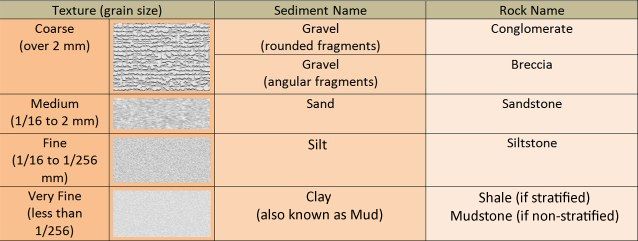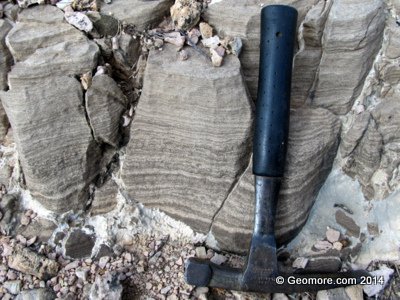Geologists Start With Sedimentary Rocks
And, the main type of rocks they study are called sedimentary rocks. Most sedimentary rocks are formed in lakes, rivers, or oceans.
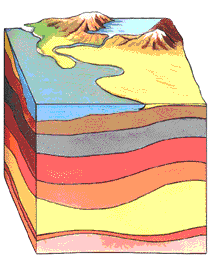 Rains fall in higher elevations, forming streams, then rivers. Rivers and streams carve out tiny bits of solid rock from the landscape and carry them downstream. If the rock bits are fairly coarse (about the size of salt grains, or larger), they are called sand. If they are a little finer, they are called silt. If the rock bits are really fine (like flour) they may be called mud, or clay. Remember, sand, silt, and mud/clay refer to the size of the grains, not what they are made of.
Rains fall in higher elevations, forming streams, then rivers. Rivers and streams carve out tiny bits of solid rock from the landscape and carry them downstream. If the rock bits are fairly coarse (about the size of salt grains, or larger), they are called sand. If they are a little finer, they are called silt. If the rock bits are really fine (like flour) they may be called mud, or clay. Remember, sand, silt, and mud/clay refer to the size of the grains, not what they are made of.
At some point in their travel, the rivers slow down. This may be because the surrounding land is very flat, or the river may enter a lake, or the ocean. When the water slows down, the grains of sand, silt, or mud being carried by the river drop to the bottom and form layers of sediment. Usually a layer will be mostly sand, mostly silt, or mostly mud, but they are often mixed up.
If you have been to a beach, you stood on a pile of sand that was eroded by the forces of rain and 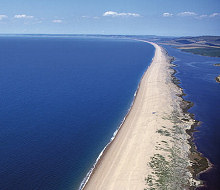 wind from rocks many hundreds of miles away, was transported by a stream or river for a long distance, was broken into tinier and tinier bits as it traveled, and was then spread out in a long, continuous bar by the work of waves, tides, and wind.
wind from rocks many hundreds of miles away, was transported by a stream or river for a long distance, was broken into tinier and tinier bits as it traveled, and was then spread out in a long, continuous bar by the work of waves, tides, and wind.
A beach is just one type of many sand deposits that may become deeply buried and later become a huge oil or gas field!
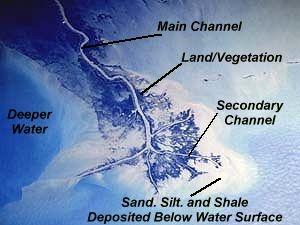
Satellite Photo – Mississippi River Delta
Here’s a slightly more complicated example. Take a look at the satellite photo of the Mississippi River’s delta. Delta is a fancy word for a big pile of sand that forms in an ocean or lake at the end of a stream or river.
In this case, the Mississippi River is bringing down a huge amount of sediment that has been scoured from all over eastern North America, and is forming new land (many miles long) right before our eyes, south of the city of New Orleans, Louisiana.
Note the main channel of the Mississippi River snaking down through the delta. The darker areas on the picture show where land sticks up (just barely, no more than a foot or two) above the surface of the ocean and allows plant life to grow. The lighter, whitish areas show sediments (sand, silt, and shale) that are just under the surface of the water. The darker blue to the left shows deeper water.
The portion of the delta visible in the photograph is about 46 miles long and 21 miles wide (74 X 33 km)! Imagine if that gigantic pile of sand and silt was buried thousands of feet deep. We would have the potential for an absolutely tremendous oil or gas field!
An Ancient Delta – Now a Gas Field!
This is where the study of geology starts to get very cool. It happens when we take modern-day examples like the Mississippi Delta (above), and find ancient systems that are very much the same.
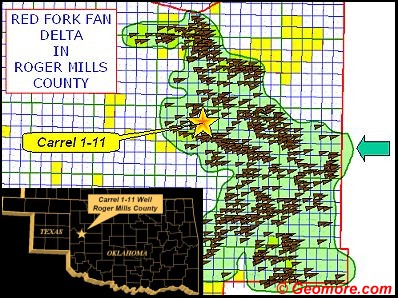
Ancient Red Fork Delta in Roger Mills County, Oklahoma – Now a Gas Field!
During Red Fork time (about 300 million years ago), most of Roger Mills County, Oklahoma was under water. Sediments from a river to the east poured into the ocean near the green arrow. The sand from the river spread out on the sea floor and formed a huge stratigraphic trap called the Red Fork delta. The Red Fork Delta is represented by the greenish area.
The brown triangles indicate oil and gas (mainly gas) wells that produce from the Red Fork formation.
Each of the blue squares is one section of land, or one square mile. So, the Red Fork Delta is about 24 miles long in the north-south direction and about 22 miles wide in the east-west direction. Not only is it big, the sediments of the Red Fork Delta are now buried very deep…over two miles deep!
Look on the Scout Ticket page to see the scout ticket from the Carrel #1-11, a well completed in the Red Fork formation in this very field!
Lithification
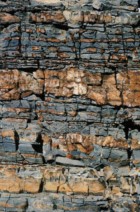 As the sediments pile up, the oldest ones are buried deeper and deeper. When they are buried deep enough, heat and pressure and other workings of the earth cement the sediments together, and turn them into rock. This process is called lithification, and sediments that have become hard and turned into rock are said to be lithified.
As the sediments pile up, the oldest ones are buried deeper and deeper. When they are buried deep enough, heat and pressure and other workings of the earth cement the sediments together, and turn them into rock. This process is called lithification, and sediments that have become hard and turned into rock are said to be lithified.
Rocks made up of sand-sized, silt-sized, or clay-sized pieces of other rocks are called clastic rocks. Clay-sized pieces are sometimes called “mud.”
The clastic rocks that are the most interesting to the petroleum geologist are classified into three types: sandstone, siltstone, and shale. More about these below.
How to Identify Sedimentary Rocks
We can classify sedimentary rocks by various factors. Some of the factors are grain size, sorting, sphericity, laminations, and porosity
Grain Size
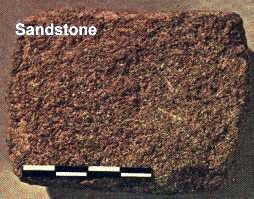
Sandstone Sample
- sandstone is formed when sand-sized sediments are lithified into rock.
- siltstone is formed when silt-sized sediments are lithified into rock.
- shale or mudstone is formed when the tiniest clay or mud-sized sediments are lithified into rock (shale is laminated, mudstone is not)..
Sandstone is a rock made up of grains that are 1/16 millimeter to 2 millimeters in size. The largest sand grains would be about 1/3 the size of a grain of rice. Grains larger than this are called pebbles, or if bigger, cobbles.
Most of the world’s oil and gas production come from sandstones and a few siltstones, with an increasing amount now coming from shale!
Simplified Grain Size Chart
Sorting
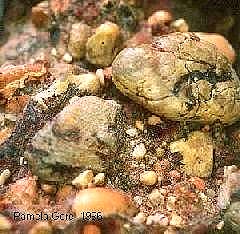
Conglomerate is Poorly-Sorted
Here is a sedimentary rock called conglomerate. The grains are too big to call this rock sandstone. However, it is made of the same materials as most sandstones. Conglomerate is very poorly sorted. This means it contains both larger and smaller grains that are out of proportion to each other.
Since conglomerate is so poorly-sorted, the spaces between the grains may contain a lot of mud or clay-sized sediments. This makes it harder for oil and gas to move through the rock, making it less attractive to the petroleum geologist. Some conglomerates do produce oil and gas, however.
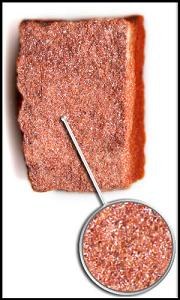 This is a coarse-grain sandstone which is made up mostly of the mineral quartz. This sandstone is well-sorted. That means most of the grains are about the same size in relation to each other. See sorting diagrams:
This is a coarse-grain sandstone which is made up mostly of the mineral quartz. This sandstone is well-sorted. That means most of the grains are about the same size in relation to each other. See sorting diagrams:

Sorting of Sedimentary Rocks
Sphericity
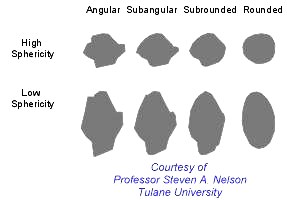
Sphericity of Grains
During transport, the edges of sharp grains are knocked off. This rounds the sediments and makes them more spherical. Note that a grain can still be angular while having high sphericity. Usually, grains toward the upper right of the chart are the types petroleum geologists look for. That’s because these well-rounded grains, when packed together, have lots of room between them. This increases the porosity of the rock, and makes it able to hold more oil and gas fluids.
Laminations
Some sandstone is laminated. This means it contains very fine layers of fine grains and coarser grains, with variations in sorting between the layers. The more laminated the petroleum reservoir, the more difficult it is to drain the oil and gas out of it efficiently.
Some sandstone is massive. “Massive” means a lack of laminations. The sandstone is very similar (not layered) from top to bottom. Massive sandstones can make excellent petroleum reservoirs.
Friability and Cementation
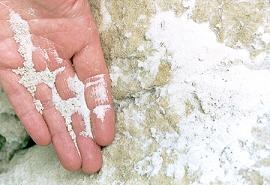
An Extremely Friable Sandstone
Most clastic sedimentary rocks consist of grains that are cemented together with minerals like calcite or quartz. Friability (fry-a-bility) is a measure of how well-cemented the grains of a clastic rock are. Some clastic rocks are not very well cemented! You can rub them to pieces in your hand! These rocks are a great find for the petroleum geologist, because the lack of cement means there is more space to fill with oil or gas!
Other clastic rocks are extremely well-cemented. Heavy cementation generally makes a poor oil and gas reservoir.
Limestone Is A Different Kind of Sedimentary Rock
The ocean, lake, and river environments were ideal for the formation of sedimentary rocks like sandstone, but they also supported a very abundant and diverse collection of living things.The seas have teemed with life for millions of years. These animals eventually died and contributed their bodies to the sediments laid down below their habitat.
Limestone is a sedimentary rock composed mainly of the bodies of dead sea animals that secrete calcium to form their skeletons. Limestone is a rock made up mainly of calcium carbonate. Many limestones are porous enough to make good oil and gas reservoirs.
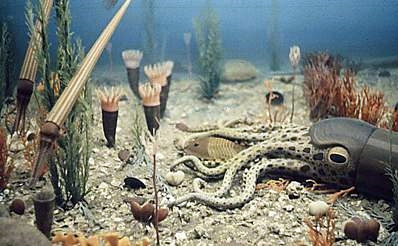
Limestone Forms on the Ancient Sea Floor
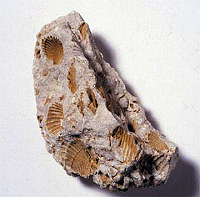
Limestone Containing Large Fossils – “Fossiliferous Limestone”
Putting It All Together
Using the above terms, the petroleum geologist can use just a few words to relate a very good description of a rock to another geologist. Here’s a typical description:
“Sandstone, well to medium-well sorted, well-rounded to subangular, very friable, very visible porosity, grayish-white, laminated with bluish-gray siltstone streaks.”

